Tips for Easy Living
"Easy Living" means going easy on yourself and on your environment.
Make your efforts pay …
- Get rid of your Dishwasher: Dishwashers use a lot of energy to heat the water and usually require you to turn up the set temperature on the Hot Water Heater (see 2). And using a dishwasher is not much less work than hand washing dishes. In fact most people seem to spend time (and water) “pre-washing” or rinsing dishes before putting them in the dishwasher. So how far ahead are they really? And dishwasher detergents are much stronger than conventional hand-detergents, containing more environmentally harmful phosphates, which encourage the growth of toxic algae in rivers and lakes.Whatever the dishwasher doesn't remove gets baked on!
- Turn down the temperature of your water heater: Set the temperature to the maximum heat that you use. This usually about 105º F. Any hotter risks burns (especially for children) while hotter water does not kill germs. And this saves a lot of energy (lowering heating Bills) while reducing stress on your Hot Water Heater giving it a longer life. Note that this is yet another reason to get rid of your automatic dishwasher, as they often call for hotter water.
- Save items that you can repurpose: Save: • Suitable spray bottles. • Old tooth brushes& nbsp; • Bread bags are handy for disposing nasty scraps, like chicken bones (otherwise they can be recycled with plastic bags). • Zip bags that are still clean can be set aside for other uses • An assortment of cardboard boxes for various uses. They can often be stacked together to save space! • Disposable aluminum pie pans or trays. • A stack of newspapers for painting or other messy jobs. • Metal Grates from discarded refrigerators or ovens. And save old scrubbing pads for really dirty one-time uses. In the spirit of recycling, repurposing is even more cost-effective and YOU reap the benefits!
- Some Special items to repurpose that are very handy: • Old toothbrushes are very handy for cleaning into crevices or corners (like in dishes, around Sinks and tubs). Keep one at your sink and a couple in your toolbox. • Large jar lids can be used to hold parts when working on small projects. • Stiff wire (coat hangers) can be formed into tools for fishing items out from crevices (like things dropped between car seats). • Eye dropper bottles can be used to dispense small amounts of oil or solvents (acetone).


- example Repurposing old strap for Hat: I recently bought a Straw Hat to keep the sun off my head …but it did not have a strap to keep it from blowing off (which happened a lot). So I looked at my collection of special strings and found this old camera strap. I cut off the camera attachment and used Sho Goo to strongly attach each end to my hat.
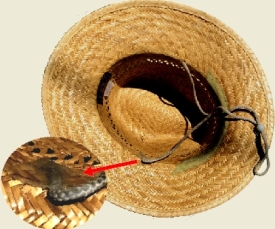
To hold the strap ends in place while the glue dried (1 day), I used a bunched-up towel and, after working the glue into the string and hat, I put a smooth plastic sheet between the glue and the towel. The next day, I did the other strap end.
- Rubber Gloves and Free Finger Cots: I reuse my rubber gloves (nitrile or latex) until they leak. Just turn them inside out while removing them and then rinse the "inside" (now outside) and hang them to dry. When needed again, turn them right side in and blow to push out the fingers. Hint: rub a little Corn Starch on your hands to make them slip on easier (maybe do this over a sink). Once they leak, cut off the good fingers to use as non-sterile finger cots and dispose the rest. These finger cots are useful for keeping a finger bandage dry (just pull it on over your bandage before washing or before messy finger-jobs (like spreading glue or paint). To avoid splitting the cots, fold the cut edge over before wearing. Once on a finger, you can often roll the cot up to easily remove and re-install as shown below:
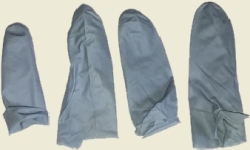
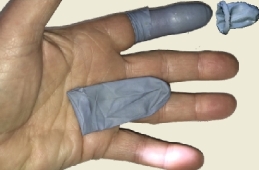
- A great use for finger cots is to put one on your thumb to prevent cuts while you are cutting things like Beans (shown here).
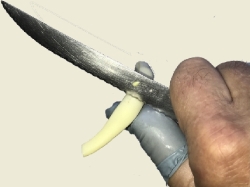
- You can often more than double the useful life of items simply by repairing them. Usually, when a product fails it is due to some design flaw, So, by fixing this flaw, you can greatly extend the product’s life (and usually spending less time than it would take to shop and replace it …which probably has the same flaw). Here are some of the best adhesives for repairs.
- Make a detergent spray bottle for small chores: Save a suitable spray bottle. Rinse it out and add about a third to a half of dish detergent with the rest being water. Shake well. Its ready to use, mixes more quickly with the wash water and its ease of dispensing will save you a lot of detergent as well as reducing water pollution.

- Use disposable aluminum trays to catch Oven Spills: When you anticipate spills (like from pies) place disposable trays under them to catch spills before they hit the oven and burn in. These trays are easier to clean because their surface was not as hot and they are removable. Don't worry about getting all the spill off. The charred parts won't reburn at next use. Otherwise: If you have a self-cleaning oven, use the clean mode right after a messy baking because the oven is already hot, reducing energy.
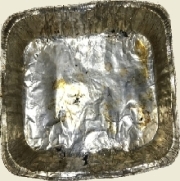
- How to wash dishes with minimal usage of water: Easy sequence:
a) Plan to do all washing and rinsing in one sink and start with just the flattest dishes (silverware, plates, lids).
b) Fill your sink with just enough water to barely cover these items and add only a little dish soap.
c) After wiping, rinse these items over the same tub, so the level rises slightly.
d) Then progress to taller dishes (plates, cups, glasses, small bowls), adding a little dish soap as needed.
e) Wipe and rinse as in (c) and progress to ever taller dishes (pans, bowls), until you are done, adding a little detergent (spray bottle?) as needed.
Suggestions:
- Use watered dish detergent as explained in (4). It dissolves easier and prevents you from over using.
- Use an old tooth brush to get into crevasses (keep one by the sink). Use Scrubbing pads for most items.
- For small jobs (like baking), use the largest bowl instead of the sink.
Washing is much easier before food has a chance to crust on. If you can't get to them before that, plan so soak any crusted-on dishes rather that spend time fighting them.
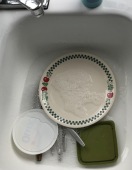
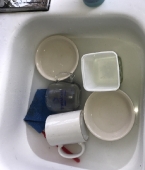
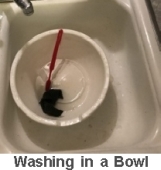
- Getting the most easily, from your thick bottled foods: It is often hard to pour thick foods from their bottle. They ooze slowly and incomplete, while you stand waiting. But there is an easier way: For things like Salad Dressing, when near the end, add a little water to the bottle, put the cap back on and then shake vigorously. Then poor the still somewhat thick liquid onto your salad. It is still quite tasty, in fact, you can often do this twice. Or when a ketchup bottle is nearly empty, save it in your refrigerator for a time when you are planning to cook a stew, chili or baked beans. Then add a little water to the ketchup bottle, shake vigorously and pour the contents into your cooking. For Cans, like Soups, which call for adding milk or water, add just half these liquids (twice) to the can, then stir with a spoon to get more of the food out. If it calls for adding a full can of liquid, fill the can half way twice, so that you have room to stir without spilling. This also leaves your containers cleaner for better recycling!
- Getting the most from your Shampoo: For shampoos or other thick liquids (detergents?), once the dispensing slows down (bottle less than a quarter full) add a little water and shake vigorously and let the bottle sit. Next time you use it, dispensing will be much easier. To add water easily, open the cap, put a little water in your cupped hand. Squeeze the bottle. Place the cap opening under the water in your cupped hand and let the bottle suck the water in. This can be done a few times, as the bottle empties, but be sure to compensate by using a little more liquid each time. You will be surprised at how much more shampoo you can use …and it flows easily This not only saves you time and money, it also it also facilitates the recycling of clean bottles.
- Better Bathing: First, realize that you normally don't have to bathe every day. In fact frequent bathing dries your skin. If you shower (which almost always uses less water than a bath) use a water-saving shower head and maybe turn off the water while you soap up. They usually have lots of spray and "Massage" settings too. Tub bathing is inherently less clean, as you are laying on your own dirty bathwater, whereas with a shower, you are being constantly rinsed by clean water.
- If refurbishing your bathroom, switch to low-water toilets and maybe even install a urinal: This will save lots of water and water scarcity will become a greater issue over time so be ahead of the trend! This may also increase the sale value of your house, while surely reducing your water bills.
- Take a picture of your Refrigerator … when you buy and install more groceries (also move older produce towards the front). That way you know what's in there without wasting time standing before the open door and needlessly stressing the refrigeration system. Instead, you can plan your meals from the couch while saving energy!
- Use a Chest-type Freezer for long-term storage: Most people need only a small freezer. I use a 7 cubic foot model, but 5 cu. ft. is probably enough for most cases. Shallower rectangular shapes are preferred over deeper square models as it is harder to find items in deeper freezers. I keep it in the basement, which is out of the way and also uses less electricity because the basement is normally cooler. I use it to store Breads, Meats, Unbaked pies, Ice cream (from sales), Basil, Peppers, Whole Tomatoes, frozen Raspberries for pies and spare ice from my ice-maker in our refrigerator. That way I can fill my cooler from home, as I pack it for a trip. The ice also acts as a hedge against any power outages by prolonging the time things stay frozen. This permanent storage allows you to buy sale items in quantity and preserve them without degrading. I like a selection of breads, but I only eat a few slices a day, so I keep them in the freezer and only take out what's needed. Certain pies (like Rhubarb, Cherry, Peach) can be made in quantity and stored raw-frozen for later. Use pie-pans that will fit into your plastic bags. To freeze, place them side-by side in the freezer (you may need a grate or boards to level them until they freeze and can be stacked). When wanted, move a raw pie from the freezer and place it in your refrigerator for two days, then remove and bake normally. So you can enjoy fresh-baked pies any time of the year! Store ripe whole Tomatoes in gallon zip-bags. Then when needed for stews, put some in a bowel and into the refrigerator for two days to thaw. The skins then peel off easily, just like as if they were blanched. Peppers can be cut to the sizes needed and frozen in plastic bowls (I use tub butter bows). Just loosen some and remove them as needed for cooking.
Most Chest-type Freezers don't have a defrost cycle (called manual defrost), which would act to freeze-dry everything. So this is what you want, because frozen items stay preserved for years. The downside is that you will occasionally want to defrost your freezer. I live in Ohio, so every winter I wait for the outside temperature to plunge to single digits and then empty my freezer contents into cardboard boxes and set them outside for a few hours. If you are not in a cold climate, use coolers to store your frozen goods during the process.
To Defrost:
A) Unplug the freezer a few hours before starting.
B) empty the frozen contents.
C) Leaving the door open, set a small plastic bowl in the freezer and carefully use a wide-bladed putty knife at a shallow angle to knockoff the loose ice. Whatever won't easily come off will loosen soon. Fill the bucket with loose ice and throw it out. Perhaps use a fan to blow warmer air into the freezer to hasten the melting.
D) Once all ice is removed, use a soft rag and mild detergent (a little dish soap) to wipe down the insides.
E) Wipe try with a towel and plug the freezer back in about a half hour before refilling.
F) Put back your frozen items and close the freezer door. DONE!
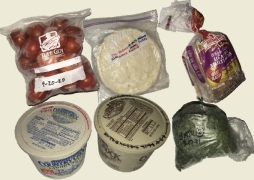
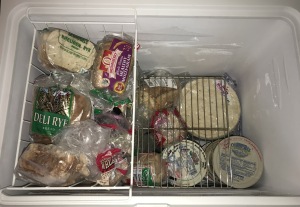
- Make Ice in the Winter: If you have Chest Freezer and a refrigerator with an ice maker. You can make ice cubes during the winter (when the heat goes into your house) and store them in plastic bags in your Chest Freezer to use in your portable Cooler during the Summer. I suggest choosing bags without any holes AND double-bagging. When needed, pull the bag out of your freezer and drop it to the floor to cause the ice to loosen.
This technique has five advantages:
• It saves heat during the Winter as the hear removed from the ice goes into your house.
• It is more efficient for your Refrigerator to make ice in colder times.
• It provides a buffer for your Freezer if the power goes out.
• It provides more “cold” and convenience for your Cooler because you can pack the Cooler in your home instead of having to drive to a store for ice.
• It saves time and money, because it is easier and far cheaper to make ice than to buy ice.
- Get a Rugged Water Bottle FREE! …and drink fresh water too: I never cease to be amazed at our "bottled water" craze. Most of this "bottled water" comes from a tap, but anyway, its just water …and old water at that. Because the "bottled water" we buy in the store was probably bottled a week ago and has been sitting in the store for days. Would you want to drink water in your home that has has been sitting out for over a week? Only if you live in a place where good water is hard to find (like along the Mississippi River), would "bottled water" be considered a better bet. Otherwise drink fresh tap water (which also must conform to regulations). Now, about that FREE Bottle: You can get very durable bottle by buying a carbonated beverage and then saving the bottle. You only pay for the drink, the bottle itself is free. And this bottle is rugged because it has to withstand the pressure of the carbonated beverage inside. If you want a lot of water bottles, buy a six-pack of carbonated beverages. I have been using the same water bottle for over 20 years! I usually just rinse it out between uses, but wash it (using an old tooth brush) then it seems dirty.

- Insulate your House with Cellulose Insulation: You can reduce your heating and cooling costs, and at the same time drastically reduce drafts and sounds from outside by having Cellulose Insulation blown into the outer walls of your house. The only downside is the potential for unsightly plugs (1 inch diameter) between every stud (about 16 inches). In places where there is a cross board (fire break) you will need holes above and below that board. You can tell by fishing a weight on a string from the top hole to see if it goes fully down. So, plan to have it done before adding siding, or do it from the inside before working on the inner walls. I took my siding off (Cedar Shingles) before having it done about 40 years ago. Cellulose Insulation flows remarkably easily from a nozzle and can find its way into most cracks. It is non-toxic and fire retardant. Learn more online
- Regenerate your COVID masks: Studies have shown that a temperature of 158°F disables over 99.99% in only a few minutes. The virus even has a hard time surviving at room temperatures and low humidity. So, what I do to both disable the COVID virus and to dry out collected moisture is to put it in a warm oven like this: 1) Set oven to the lowest setting (150º to 170ºF). 2) When oven is at temperature, turn it off and wait a few minutes for the oven walls to absorb the heat. 3) Put your mask on a metal tray and put it in the oven. Opening the oven lets any moisture out (if a Gas oven) and assures that the temperature is not too high. 4) Forget about it. After a couple hours, or later, when you are nearby, remove your mask and put it away fresh for next usage.
OR: If it is a warm sunny day, hang your COVID mask outside, in the sunlight, since the UV light in sunlight quickly destroys the virus (as well as drying the mask).
![Mask1 in n]metal plate](images/mask1.jpg)

- Location, Location, Location:Given all looming problems of climate change, it would be wise to consider where you will live over the next decades. You would fair better if you lived where you had: 1) a reliable drinkable water supply. 2) Nearby (statewide?) food production. 3) Lower temperatures and humidity. A "Wet-bulb" (dew Point) temperature of 95ºF and above is deadly because it is too humid to cool oneself by sweating. 4) A reliable electric supply. 5) A region that are relatively safe from: Hurricanes, Tornados, Flooding, Drought, Forest Fires or Wildfires. Note that when temperatures rise, people rely on AC to cool down, which puts maximum strain on the electric supply. A power failure during a heat wave would leave the population with few or no options. Already, intense heat waves are killing animals and birds in some places are falling dead from the sky. And it will be getting worse for a long time.
For the U.S. this means avoiding the Southern States and both the East and West coasts. The most survivable places in the long run are states like Wisconsin, Indiana, Michigan, Ohio and Pennsylvania. Ironically the population seems to be moving toward loser states like Texas, Arizona and Florida! Yet Northern Ohio has abundant fresh water (Lake Erie), stable weather, few storms, good farmland, increasing parkland development (river, hiking and biking) and even a low cost of living!
Worldwide, the worst places are probably the Middle East, Central Africa and India. The best places are probably Canada, Northern Europe, Ukraine and even Russia (if it weren’t for political instability).
- Can you change your tire? I see so many cars trying to drive on a flat, to get service for a flat tire. This quickly destroys their tire and often the rim too. You should know how to change a tire (and where the spare and the jack is located), and this also means being able to loosen the lug nuts. Service centers, with their "impact wrenches" always tighten the lug nut too tight. So the first thing you should do after tire service (changing, rotating or balancing) is to check that you are able to loosen the lug nuts in case of a flat tire. The second thing is to know where to place the car jack for each wheel (see owners manual) and to remember to engage the emergency brake before jacking.
- Come easy, Go Easy? Go Natural! The subject of what to do with your body after you pass on is difficult to contemplate. Yet it is a subject we all have to face. Personally, I see cremation as a very violent process (Over 1000°F, besides being a waste of fuel). I would prefer to be buried, like my parents were, but I also realize that we will soon run out of space for this and embalming involves replacing your blood with toxic chemicals. Composting is a more natural and more gentle way out. So I am slowly coming to accept a new process: Human Composting. Actually, it is a quite natural end. We are born from dust and we eventually return to dust (regardless of the method chosen). Looking into this, I found that composting along with wood chips and plants only takes about a month and uses minimal energy. Plus it pays back in useful compost that can be used to promote future life. Today (in 2023) it is now legal in six States in the U.S. (Washington, California, Oregon, Colorado, Vermont and now New York) and is rapidly becoming popular. There are even places where you can have your body sent to states that allow composting. If interested, you should put a directive in your Will and perhaps notify your State legislators. See alternatives online or watch this Video
Ray Herrmann

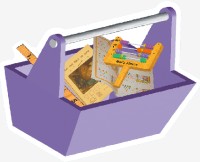
















![Mask1 in n]metal plate](images/mask1.jpg)
